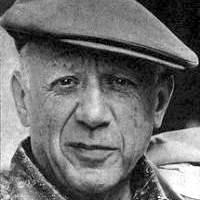“It means nothing to me. I have no opinion about it, and I don't care.”
On the first moon landing, quoted in The New York Times (1969-07-21).
1960s
Pablo Ruiz Picasso was a Spanish painter, sculptor, printmaker, ceramicist, stage designer, poet and playwright who spent most of his adult life in France. Regarded as one of the most influential artists of the 20th century, he is known for co-founding the Cubist movement, the invention of constructed sculpture, the co-invention of collage, and for the wide variety of styles that he helped develop and explore. Among his most famous works are the proto-Cubist Les Demoiselles d'Avignon , and Guernica , a dramatic portrayal of the bombing of Guernica by the German and Italian airforces during the Spanish Civil War.
Picasso demonstrated extraordinary artistic talent in his early years, painting in a naturalistic manner through his childhood and adolescence. During the first decade of the 20th century, his style changed as he experimented with different theories, techniques, and ideas. After 1906, the Fauvist work of the slightly older artist Henri Matisse motivated Picasso to explore more radical styles, beginning a fruitful rivalry between the two artists, who subsequently were often paired by critics as the leaders of modern art.Picasso's work is often categorized into periods. While the names of many of his later periods are debated, the most commonly accepted periods in his work are the Blue Period , the Rose Period , the African-influenced Period , Analytic Cubism , and Synthetic Cubism , also referred to as the Crystal period. Much of Picasso's work of the late 1910s and early 1920s is in a neoclassical style, and his work in the mid-1920s often has characteristics of Surrealism. His later work often combines elements of his earlier styles.
Exceptionally prolific throughout the course of his long life, Picasso achieved universal renown and immense fortune for his revolutionary artistic accomplishments, and became one of the best-known figures in 20th-century art.
Wikipedia

“It means nothing to me. I have no opinion about it, and I don't care.”
On the first moon landing, quoted in The New York Times (1969-07-21).
1960s
“For a long time I limited myself to one colour — as a form of discipline.”
quoted in Picasso on Art (1988), ed. Dore Ashton
quote on Picasso's 'Blue' and 'Rose' periods
Attributed from posthumous publications
“I don't know where he [ Marc Chagall ] gets those images; he must have an angel in his head.”
As quoted in Marc Chagall, – a Biography, by Sidney Alexander, Cassell, London, 1978, p. 33
Attributed from posthumous publications
“Good artists copy, great artists steal.”
Compare: "Immature poets imitate; mature poets steal." T. S. Eliot, in Philip Massinger, in The Sacred Wood (1920)
Disputed
“The urge to destroy is also a creative urge.”
Attributed by Banksy on Instagram (October 6, 2018): "The urge to destroy is also a creative urge" - Picasso https://www.instagram.com/p/BomXijJhArX/?hl=en&taken-by=banksy. This was actually written by anarchist philosopher Mikhail Bakunin in his essay "Reaction in Germany," in 1842.
Source: Moore, John (2004). I Am Not a Man, I Am Dynamite!: Friedrich Nietzsche and the Anarchist Tradition. Brooklyn NY: Autonomedia. p. 87.
Source: Lehning, Arthur, ed. (1973). Mikhail Bakunin: Selected Writings. London: Cape. p. 58.
Misattributed